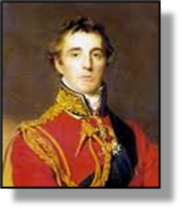
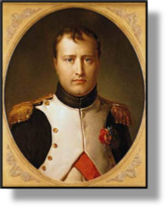 xxxxxAs we have seen, Napoleon was exiled to Elba in May 1814 but, learning of widespread discontent with the government of the restored Bourbon monarch, Louis XVIII, he decided to make a come-back. On his arrival in Paris in March 1815, Napoleon attempted to establish himself as a constitutional monarch, though, in fact, the regime he began to put in place hardly differed from that set up by Louis XVIII a year earlier. In the meantime, however, the powers at Vienna were in no mood to compromise. Alarmed by this turn of events, they formed a new alliance and appointed the Duke of Wellington (illustrated left) as the supreme commander of the Allied forces. Britain, Prussia, Austria and Russia prepared for war.
xxxxxAs we have seen, Napoleon was exiled to Elba in May 1814 but, learning of widespread discontent with the government of the restored Bourbon monarch, Louis XVIII, he decided to make a come-back. On his arrival in Paris in March 1815, Napoleon attempted to establish himself as a constitutional monarch, though, in fact, the regime he began to put in place hardly differed from that set up by Louis XVIII a year earlier. In the meantime, however, the powers at Vienna were in no mood to compromise. Alarmed by this turn of events, they formed a new alliance and appointed the Duke of Wellington (illustrated left) as the supreme commander of the Allied forces. Britain, Prussia, Austria and Russia prepared for war.
xxxxxNapoleon, of course, had anticipated such a move. On his way through France and after two months in Paris he had mustered a sizeable army. There was no shortage of men who had served him loyally over the past ten years, and this number had been bolstered by the return of thousands of prisoners from the Russian front. In June, determined to strike before the arrival of troops from Austria and Russia could tip the balance in the Allies’ favour, he advanced swiftly into present-day Belgium. There the Prussians, under their commander in chief Gebhard Leberecht von Blücher, were quartered at Charleroi, Namur, Dinant and Liège, and the British were strung out along the frontier from Ostend to Mons. On the 16th of the month Napoleon himself took on the Prussians and, defeating them at the Battle of Ligny, forced them to retreat. On the same day and in the same hour, Marshal Ney confronted Wellington’s forces at the Battle of Quatre Bras. The engagement was indecisive, both sides holding their ground, but as night fell Wellington decided to withdraw his troops to a more advantageous position close to the village of Waterloo, eight miles south of Brussels. It was here that two days later Napoleon and Ney, anxious to strike at Wellington whilst the Prussians were in disarray, combined forces and sought to resolve the conflict.
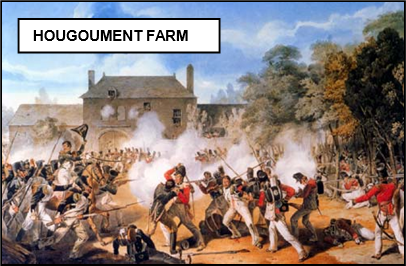 xxxxxThe Battle of Waterloo, June 1815, raged over an area of about three square miles. Wellington had a force of some 68,000, a third being British and the remainder made up of Dutch, Belgian and German contingents. Napoleon’s army was 105,000 strong, but of this number over 30,000, led by the Marquis de Grouchy, were despatched to block the arrival of the Prussians - then regrouping after their defeat two days earlier. Because of heavy rain over night, Napoleon delayed his attack until around 11am, and then, over the next six hours, launched a series of powerful attacks - foot, horse and artillery - against the Allies, some of the fiercest fighting taking place around the chateau of Hougoumont. Throughout this sustained assault Wellington’s forces suffered heavy casualties, but they held their line by fending off the enemy with cavalry charges, and forming infantry squares capable of rapid and accurate fire. At one stage Ney’s cavalry - his “sea of steel” - managed to seize control of Mont-Saint-Jean, but after holding the height for three hours they were forced to withdraw.
xxxxxThe Battle of Waterloo, June 1815, raged over an area of about three square miles. Wellington had a force of some 68,000, a third being British and the remainder made up of Dutch, Belgian and German contingents. Napoleon’s army was 105,000 strong, but of this number over 30,000, led by the Marquis de Grouchy, were despatched to block the arrival of the Prussians - then regrouping after their defeat two days earlier. Because of heavy rain over night, Napoleon delayed his attack until around 11am, and then, over the next six hours, launched a series of powerful attacks - foot, horse and artillery - against the Allies, some of the fiercest fighting taking place around the chateau of Hougoumont. Throughout this sustained assault Wellington’s forces suffered heavy casualties, but they held their line by fending off the enemy with cavalry charges, and forming infantry squares capable of rapid and accurate fire. At one stage Ney’s cavalry - his “sea of steel” - managed to seize control of Mont-Saint-Jean, but after holding the height for three hours they were forced to withdraw.
xxxxxIn the meanwhile, however, the first of the Prussian elements, a corps under General von Bülow, had managed to evade the French forces under the Marquis de Grouchy and arrive on the battlefield. These troops set about attacking the French along their eastern flank and, to halt their advance and prevent a serious breakthrough, Napoleon was obliged to send reinforcements from his central front, including several battalions of his Imperial Guard. Thus when Ney eventually managed to capture La Haye Sainte, a farmhouse strategically placed in the centre of the Allied line, he was unable to press home his advantage. Having inflicted heavy casualties on the enemy and seen a gap in their defences, his urgent call for additional infantry was denied at the crucial moment. By the time Napoleon had released battalions from the eastern flank - having finally secured that sector - Wellington had regrouped and been reinforced by the arrival of yet more Prussian troops, this time under the command of General von Zieten.
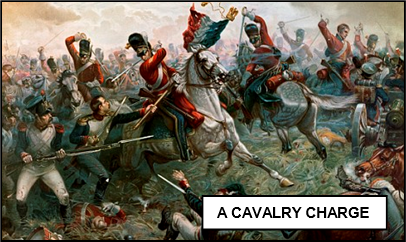 xxxxxThexfinal French attack came around 6 pm, when Napoleon, having learnt that General Blücher (1742-1819) was approaching with the bulk of his army, sent in eight battalions of his Imperial Guard together with other units. They advanced in good order, but when they came within striking distance of the Allied line, Wellington ordered his own guardsman to break cover and open fire. The withering volley from the British Guards division tore into the serried ranks of the advancing French forces, destroying well over half their number. They fell back and then scattered in the face of a counterattack. And it was at this juncture that Blücher, having left his rearguard to tie down Grouchy’s force near Wavre, arrived on the battlefield with the bulk of his army, some 45,000 men. His arrival made certain an Allied victory. Having captured the village of Plancenoit, the Prussian cavalry spent the night driving the remnants of the French army towards Paris. By the end of the battle Napoleon had lost about 25,000 killed and wounded, and the Allies a similar number - perhaps somewhat smaller.
xxxxxThexfinal French attack came around 6 pm, when Napoleon, having learnt that General Blücher (1742-1819) was approaching with the bulk of his army, sent in eight battalions of his Imperial Guard together with other units. They advanced in good order, but when they came within striking distance of the Allied line, Wellington ordered his own guardsman to break cover and open fire. The withering volley from the British Guards division tore into the serried ranks of the advancing French forces, destroying well over half their number. They fell back and then scattered in the face of a counterattack. And it was at this juncture that Blücher, having left his rearguard to tie down Grouchy’s force near Wavre, arrived on the battlefield with the bulk of his army, some 45,000 men. His arrival made certain an Allied victory. Having captured the village of Plancenoit, the Prussian cavalry spent the night driving the remnants of the French army towards Paris. By the end of the battle Napoleon had lost about 25,000 killed and wounded, and the Allies a similar number - perhaps somewhat smaller.
xxxxxOnly the rearguard action of the Old Guard - what was left of it - enabled Napoleon to make his own escape. He reached the capital safely, but parliament would give him no support and forced him to abdicate - for the second and last time - at the end of the month. Early in July he managed to make his way to Rochefort where he hoped to take a ship to the United States, but the British navy had blockaded the port, and he was forced to seek protection from the British government. He surrendered to the captain of the British warship Bellerophon and taken to England, but he never went ashore. He was put aboard the Northumberland and taken to Saint Helena, a small island in the southern Atlantic. There he was closely guarded, but had the company of a few loyal friends. Undisturbed, he was able to dictate his memoirs, thereby creating his own version of the Napoleonic legend. In the meanwhile, Louis XVIII returned to what he saw as his rightful place, and the Congress of Vienna resumed its deliberations, anxious, like Louis, to turn the clock back to the old order. Thus ended 23 years of almost continuous warfare between France and - at one time or another - almost every other nation or would-be nation in Europe.
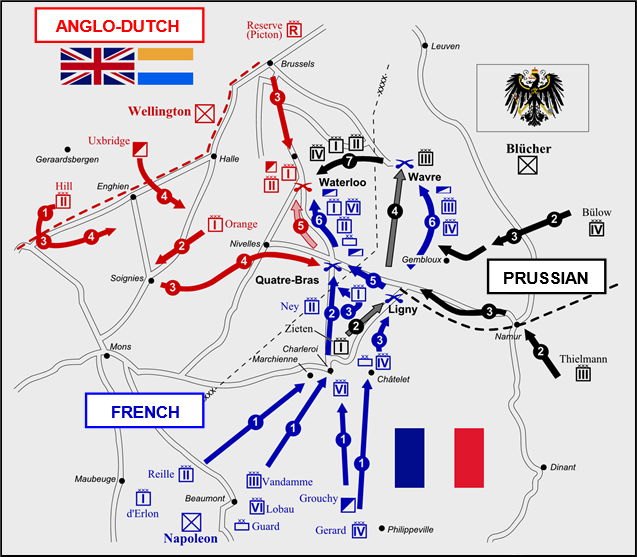 xxxxxNapoleon’s defeat at the Battle of Waterloo is more often than not put down to the fact that he delayed his opening attack until close on midday. Certainly this postponement gave Blücher the time he needed to march to Waterloo. Two of his corps reached the battlefield during the afternoon, and played a vital if not decisive part in the fighting, and Blücher himself arrived early in the evening and ensured an Allied victory. Some historians claim that Napoleon blundered by deciding to give time for the ground to dry out after the heavy overnight rain; others that he saw no immediate danger from the Prussians and thought he had time enough to deal with Wellington, that 3rd-rate “Sepoy General”. It is worth noting, however, that when he did launch his attack, his infantry and cavalry had difficulty in crossing the muddy terrain, and some of his artillery became bogged down. If he had made his assault four or five hours earlier the condition of the ground would have been appreciably worse and the attack may well have ended in total disaster.
xxxxxNapoleon’s defeat at the Battle of Waterloo is more often than not put down to the fact that he delayed his opening attack until close on midday. Certainly this postponement gave Blücher the time he needed to march to Waterloo. Two of his corps reached the battlefield during the afternoon, and played a vital if not decisive part in the fighting, and Blücher himself arrived early in the evening and ensured an Allied victory. Some historians claim that Napoleon blundered by deciding to give time for the ground to dry out after the heavy overnight rain; others that he saw no immediate danger from the Prussians and thought he had time enough to deal with Wellington, that 3rd-rate “Sepoy General”. It is worth noting, however, that when he did launch his attack, his infantry and cavalry had difficulty in crossing the muddy terrain, and some of his artillery became bogged down. If he had made his assault four or five hours earlier the condition of the ground would have been appreciably worse and the attack may well have ended in total disaster.
xxxxxPerhapsxthe main roots of his failure lie elsewhere. At the satellite battle at Ligny on June 16th, for example, Napoleon’s marshal Emmanuel de Grouchy (1766-1847) was sent in pursuit of the retreating Prussians but, given false information, he marched in the wrong direction and never found them. Had he done so, the Prussians might well have taken more time to regroup. Likewise before the fighting began at Waterloo, Grouchy was despatched with 33,000 men to impede if not stop any Prussian reinforcements reaching the battlefield, but again, so it would seem, he was given garbled instructions. As a result, two Prussian corps managed to evade him in the afternoon, and in the evening Blücher succeeded in tying him down at Wavre by means of his rearguard - just 17,000 strong - while he himself marched to Wellington’s aid with the bulk of his army.
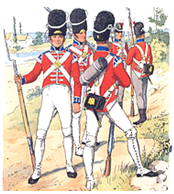 xxxxxOn the battlefield itself there was often a lack of co-ordination between the French infantry and cavalry - possibly caused by the muddy conditions - and Wellington’s tactics, developed during the Peninsular War, proved highly successful. He kept his army along the high ground that he commanded, and he used this ridge to conceal and protect his musketeers until there was a need for rapid and precise firepower. Later, Napoleon blamed his failure on the "obstinate bravery of the ‘English’ troops" (illustrated). But it was not all one way. When, in the late afternoon Ney eventually broke through the allied line and captured the farmhouse, Le Haye Sainte, the battle hung in the balance. It was, as Wellington admitted afterwards, “the nearest run thing you ever saw in your life”.
xxxxxOn the battlefield itself there was often a lack of co-ordination between the French infantry and cavalry - possibly caused by the muddy conditions - and Wellington’s tactics, developed during the Peninsular War, proved highly successful. He kept his army along the high ground that he commanded, and he used this ridge to conceal and protect his musketeers until there was a need for rapid and precise firepower. Later, Napoleon blamed his failure on the "obstinate bravery of the ‘English’ troops" (illustrated). But it was not all one way. When, in the late afternoon Ney eventually broke through the allied line and captured the farmhouse, Le Haye Sainte, the battle hung in the balance. It was, as Wellington admitted afterwards, “the nearest run thing you ever saw in your life”.
xxxxxAs is to be expected, History’s Verdict on Napoleon is a mixed one, but by any standards he was a most remarkable man. Physically, he was only 5ft 6ins tall, but his personality was giant size. He radiated an energy and a confidence that inspired all who met him. Above all he possessed that indefinable gift of leadership that set him apart and way above other men. Exceptionally intelligent, 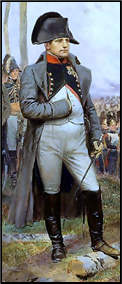 prompt in the making of decisions, and with an incredible ability to get the best out of people, he was tireless in the pursuit of his aims, be they on the battlefield or concerned with political and administrative reform. And with this capacity for hard work and a mind like a “filing cabinet”, went an almost insatiable ambition. He saw himself as a man of history, destined to unite Europe like the Great Charlemagne had done before him.
prompt in the making of decisions, and with an incredible ability to get the best out of people, he was tireless in the pursuit of his aims, be they on the battlefield or concerned with political and administrative reform. And with this capacity for hard work and a mind like a “filing cabinet”, went an almost insatiable ambition. He saw himself as a man of history, destined to unite Europe like the Great Charlemagne had done before him.
xxxxxAnd this overriding confidence in his own ability was never more apparent than on the battlefield. He was one of the greatest military commanders of all time. By his rapport with his men and his genuine concern for their welfare, he inspired loyalty and trust, not only within the lower ranks but also among experienced commanders who, though senior to him in years, were honoured to serve under him. In reorganising the army on modern lines, two factors above all won him a place in their hearts. He promoted on the basis of ability, not social status, and, put quite simply, he had the knack of winning the battles he fought. In so doing, he was not so much a military tactician as a brilliant strategist. He used speed and deception to surprise his enemy and with very few exceptions - Waterloo being one - he chose the ground on which he fought, enabling him to concentrate his force where it was most effective.
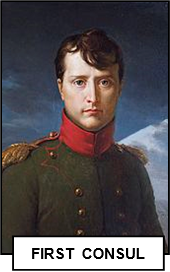 xxxxxBut his triumphs on the battlefield were more than matched by his achievements in domestic reform - and they also proved more enduring. His five years as First Consul were remarkable for the improvements he made in financial, political and educational institutions, improvements which proved of lasting value not only in France, but in much of Western Europe as well. He made solvent the nation’s finances, overhauled and centralised government, improved and extended the educational system, and, by the Napoleonic Code, provided a uniform judicial system which upheld the revolutionary ideals of individual liberty, equality before the law, and freedom of conscience. These reforms, together with significant improvements in communications, extended trade, increased prosperity, and provided the very foundation of a modern nation’s administration. He once expressed the wish that he be remembered above all for the qualities he possessed as a civic ruler, and to a large extent that is how it has proved to be.
xxxxxBut his triumphs on the battlefield were more than matched by his achievements in domestic reform - and they also proved more enduring. His five years as First Consul were remarkable for the improvements he made in financial, political and educational institutions, improvements which proved of lasting value not only in France, but in much of Western Europe as well. He made solvent the nation’s finances, overhauled and centralised government, improved and extended the educational system, and, by the Napoleonic Code, provided a uniform judicial system which upheld the revolutionary ideals of individual liberty, equality before the law, and freedom of conscience. These reforms, together with significant improvements in communications, extended trade, increased prosperity, and provided the very foundation of a modern nation’s administration. He once expressed the wish that he be remembered above all for the qualities he possessed as a civic ruler, and to a large extent that is how it has proved to be.
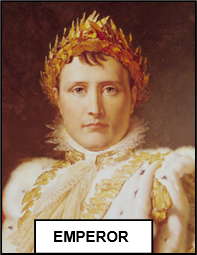 xxxxxAnd it was during his years as First Consul that Napoleon built up his Grande Armée, that superb fighting force (a nation under arms) which, over the next ten years or so, was to give him dominion over almost the whole of continental Europe. Having inherited the French Revolution, he saw it his duty to preserve its achievements and pass on the benefits to Europe within a federation of free peoples, liberated from reactionary monarchies. But unfortunately, what began as self-defence and liberal intentions ended up as self-indulgence and despotic rule. Power, his acknowledged “mistress”, went to his head. He made himself Emperor of a country which had gone through purgatory to become a republic, and of a Europe which, having been “liberated”, found itself dominated by foreign troops. Thus the French people themselves began to question their leader’s motives, and the individual nations of Europe prepared to fight for their own language, culture and territory. Rejecting Napoleon’s concept of a united Europe ruled from Paris, countries like Italy, Spain, Belgium and the fledgling state of Germany - united in part within the Confederation of the Rhine - now sought their own independence and, where possible, the democratic reforms that should go with it. The seeds of Nationalism and Liberalism had been sown, and they were to be the driving forces of the 19th century.
xxxxxAnd it was during his years as First Consul that Napoleon built up his Grande Armée, that superb fighting force (a nation under arms) which, over the next ten years or so, was to give him dominion over almost the whole of continental Europe. Having inherited the French Revolution, he saw it his duty to preserve its achievements and pass on the benefits to Europe within a federation of free peoples, liberated from reactionary monarchies. But unfortunately, what began as self-defence and liberal intentions ended up as self-indulgence and despotic rule. Power, his acknowledged “mistress”, went to his head. He made himself Emperor of a country which had gone through purgatory to become a republic, and of a Europe which, having been “liberated”, found itself dominated by foreign troops. Thus the French people themselves began to question their leader’s motives, and the individual nations of Europe prepared to fight for their own language, culture and territory. Rejecting Napoleon’s concept of a united Europe ruled from Paris, countries like Italy, Spain, Belgium and the fledgling state of Germany - united in part within the Confederation of the Rhine - now sought their own independence and, where possible, the democratic reforms that should go with it. The seeds of Nationalism and Liberalism had been sown, and they were to be the driving forces of the 19th century.
xxxxxThe Napoleonic legend, enhanced by Napoleon’s own memoirs and made nostalgically attractive amid the turbulent politics which followed his fall, was not without consequence. As we shall see, the glory and glamour of the man who was master of France at the age of 30, and virtual ruler of Europe just six years later, made possible the founding of a Second Empire in 1852 (Va), when Napoleon’s nephew seized the crown and made himself Napoleon III. Like the first one, this empire was also to end in military defeat.
xxxxxIncidentally, at the Battle of Waterloo, another reason has been advanced for Napoleon’s decision to postpone his opening attack until midday. It seems that he suffered badly from haemorrhoids (piles) and that he had a particularly painful bout of this complaint on the morning of the battle, and was obliged to undergo medical treatment for several hours. ……
xxxxx…… Duringxhis Egyptian campaign in the late 1790s (his “romantic interlude”), Napoleon saw himself as building a vast empire in the east, somewhat on the lines of Alexander the Great. Having conquered Egypt, he advanced into Palestine and Syria but failed to take Acre, due in large part to the stubborn defence put up by the British Admiral Sir Sydney Smith. “That man, Napoleon remarked later, “made me miss my destiny”. ……
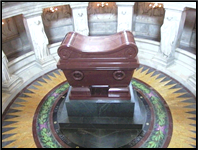 xxxxx…… Napoleon died in May 1821, aged 51. His body was dressed in the uniform of the Chasseurs de la Garde, and covered by the grey overcoat that he had worn at the Battle of Marengo. He was buried by a stream in Rupert’s Valley, but his tombstone only bore the words Ci-Git (Here Lies). In 1840, however, his remains were taken to the bank of the Seine - in accordance with his last wishes - and in December of that year, following an impressive funeral, his body was conveyed through the Arc de Triomphe (built as a monument to his victories), and placed in a tomb under the dome of Les Invalides (illustrated) in the Champs Élysées. ……
xxxxx…… Napoleon died in May 1821, aged 51. His body was dressed in the uniform of the Chasseurs de la Garde, and covered by the grey overcoat that he had worn at the Battle of Marengo. He was buried by a stream in Rupert’s Valley, but his tombstone only bore the words Ci-Git (Here Lies). In 1840, however, his remains were taken to the bank of the Seine - in accordance with his last wishes - and in December of that year, following an impressive funeral, his body was conveyed through the Arc de Triomphe (built as a monument to his victories), and placed in a tomb under the dome of Les Invalides (illustrated) in the Champs Élysées. ……
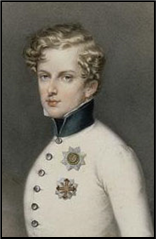
xxxxx…… Onxthe death of Napoleon, his son, François Charles Joseph Bonaparte (1811-1832), then 10 years old, was dubbed Napoleon II by the Bonapartists, but it was a title in name only. After Napoleon’s exile to Elba in 1814, the Empress Marie had taken their son, then known as the King of Rome, to the court of Austria, and it was there that he spent the rest of his life. By the Treaty of Paris he was excluded from succeeding to his mother’s Italian lands, but in 1818 he was given the Austrian title of the Duke of Reichstadt. By the time Charles X of France was overthrown in 1830, he was seriously ill with tuberculosis, and he died of this complaint two years later.




 xxxxxAs we have seen, Napoleon was exiled to Elba in May 1814 but, learning of widespread discontent with the government of the restored Bourbon monarch, Louis XVIII, he decided to make a come-
xxxxxAs we have seen, Napoleon was exiled to Elba in May 1814 but, learning of widespread discontent with the government of the restored Bourbon monarch, Louis XVIII, he decided to make a come- xxxxxThe Battle of Waterloo, June 1815, raged over an area of about three square miles. Wellington had a force of some 68,000, a third being British and the remainder made up of Dutch, Belgian and German contingents. Napoleon’s army was 105,000 strong, but of this number over 30,000, led by the Marquis de Grouchy, were despatched to block the arrival of the Prussians -
xxxxxThe Battle of Waterloo, June 1815, raged over an area of about three square miles. Wellington had a force of some 68,000, a third being British and the remainder made up of Dutch, Belgian and German contingents. Napoleon’s army was 105,000 strong, but of this number over 30,000, led by the Marquis de Grouchy, were despatched to block the arrival of the Prussians - xxxxxThexfinal French attack came around 6 pm, when Napoleon, having learnt that General Blücher (1742-
xxxxxThexfinal French attack came around 6 pm, when Napoleon, having learnt that General Blücher (1742- xxxxxNapoleon’s defeat at the Battle of Waterloo is more often than not put down to the fact that he delayed his opening attack until close on midday. Certainly this postponement gave Blücher the time he needed to march to Waterloo. Two of his corps reached the battlefield during the afternoon, and played a vital if not decisive part in the fighting, and Blücher himself arrived early in the evening and ensured an Allied victory. Some historians claim that Napoleon blundered by deciding to give time for the ground to dry out after the heavy overnight rain; others that he saw no immediate danger from the Prussians and thought he had time enough to deal with Wellington, that 3rd-
xxxxxNapoleon’s defeat at the Battle of Waterloo is more often than not put down to the fact that he delayed his opening attack until close on midday. Certainly this postponement gave Blücher the time he needed to march to Waterloo. Two of his corps reached the battlefield during the afternoon, and played a vital if not decisive part in the fighting, and Blücher himself arrived early in the evening and ensured an Allied victory. Some historians claim that Napoleon blundered by deciding to give time for the ground to dry out after the heavy overnight rain; others that he saw no immediate danger from the Prussians and thought he had time enough to deal with Wellington, that 3rd- xxxxxOn the battlefield itself there was often a lack of co-
xxxxxOn the battlefield itself there was often a lack of co- prompt in the making of decisions, and with an incredible ability to get the best out of people, he was tireless in the pursuit of his aims, be they on the battlefield or concerned with political and administrative reform. And with this capacity for hard work and a mind like a “filing cabinet”, went an almost insatiable ambition. He saw himself as a man of history, destined to unite Europe like the Great Charlemagne had done before him.
prompt in the making of decisions, and with an incredible ability to get the best out of people, he was tireless in the pursuit of his aims, be they on the battlefield or concerned with political and administrative reform. And with this capacity for hard work and a mind like a “filing cabinet”, went an almost insatiable ambition. He saw himself as a man of history, destined to unite Europe like the Great Charlemagne had done before him. xxxxxBut his triumphs on the battlefield were more than matched by his achievements in domestic reform -
xxxxxBut his triumphs on the battlefield were more than matched by his achievements in domestic reform - xxxxxAnd it was during his years as First Consul that Napoleon built up his Grande Armée, that superb fighting force (a nation under arms) which, over the next ten years or so, was to give him dominion over almost the whole of continental Europe. Having inherited the French Revolution, he saw it his duty to preserve its achievements and pass on the benefits to Europe within a federation of free peoples, liberated from reactionary monarchies. But unfortunately, what began as self-
xxxxxAnd it was during his years as First Consul that Napoleon built up his Grande Armée, that superb fighting force (a nation under arms) which, over the next ten years or so, was to give him dominion over almost the whole of continental Europe. Having inherited the French Revolution, he saw it his duty to preserve its achievements and pass on the benefits to Europe within a federation of free peoples, liberated from reactionary monarchies. But unfortunately, what began as self- xxxxx…… Napoleon died in May 1821, aged 51. His body was dressed in the uniform of the Chasseurs de la Garde, and covered by the grey overcoat that he had worn at the Battle of Marengo. He was buried by a stream in Rupert’s Valley, but his tombstone only bore the words Ci-
xxxxx…… Napoleon died in May 1821, aged 51. His body was dressed in the uniform of the Chasseurs de la Garde, and covered by the grey overcoat that he had worn at the Battle of Marengo. He was buried by a stream in Rupert’s Valley, but his tombstone only bore the words Ci-



